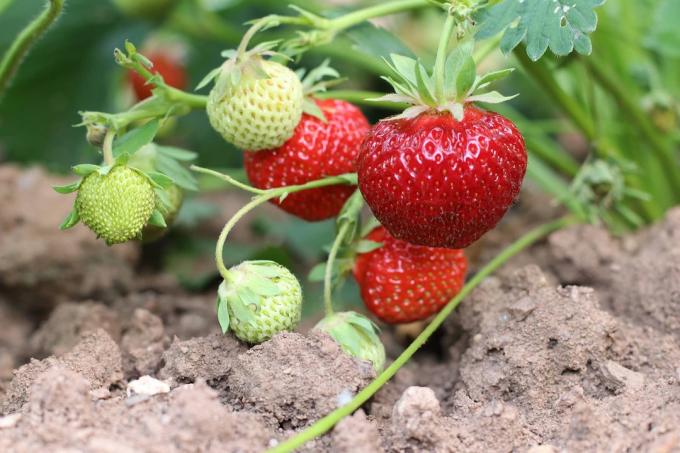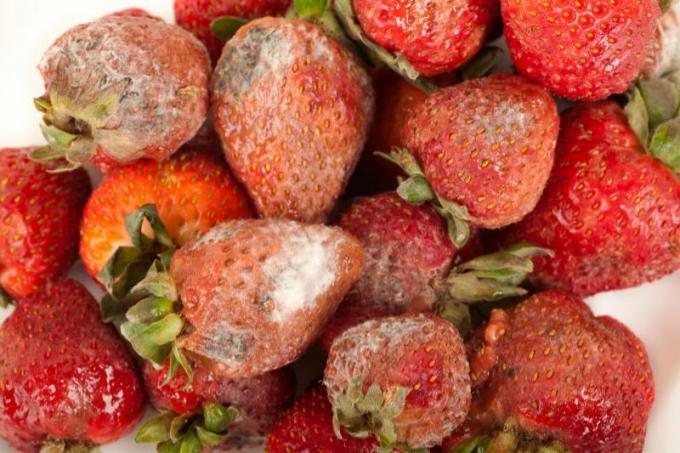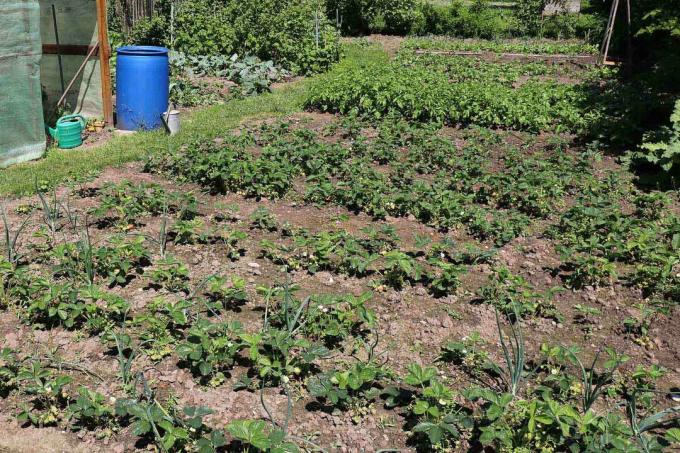
The bright red berries are among the most popular and tastiest garden fruits. But what if strawberries don't turn red and spoil before then, what can be the reason and what can you do?
In a nutshell
- Not every variety red
- Deficiency symptoms most common causes
- Diseases also affect red coloration
- Optimal conditions prevent
Table of contents
- causes and remedy
- deficiency symptoms
- phosphate deficiency
- nitrogen deficiency
- diseases as a cause
- Leatherberry rot (Phytophthora cactorum)
- Gnomonia fruit rot (Gnomonia fruticola)
- Create optimal conditions
- frequently asked Questions
causes and remedy
If the tasty little fruits don't turn red, it can mean that they are special breeds with white fruits, such as the 'Snow White' pineapple strawberry or the 'White Baron' strawberry of the month Solemacher'. If a variety that is actually red does not turn red, deficiency symptoms can also be the cause of diseases.

deficiency symptoms
phosphate deficiency
If the strawberries do not turn red or if this is disturbed, there may be deficiency symptoms, e.g. B. a phosphate deficiency. Causes are:
- too cold or wet conditions
- on acidic or strongly alkaline soils
- little organic matter
The deficiency reduces growth and delays flowering and fruit ripening. If the fruits are small, this can also be a sign of albinism. One remedy long-term phosphate fertilization.

nitrogen deficiency
Nitrogen deficiency occurs:
- especially on slightly sandy soils
- with little organic matter
- or insufficient nitrogen fertilization
- by using bark mulch
Older leaves are chlorotic, die off and the fruits are usually hard and less colored. To counteract this, repeated low fertilization can help, especially during periods of need. Increasing the organic matter in the soil can also help.
Tip: To be sure that there is indeed a nitrogen deficiency, it is advisable to test the soil for its nutrient content.
diseases as a cause
Leatherberry rot (Phytophthora cactorum)
Sometimes are too Diseases responsible for the fruit not taking on the typical red color or developing it only weakly. In the case of leatherberry rot, the fungal spores reach the plant or soil via the spray water. the fruits and can cause corresponding symptoms there.
- Symptoms depend on the ripeness of the fruit
- Infestation predominantly on unripe, still green fruits
- especially those near the ground
- on ripe, already red fruits, infestation is rarer
- favored by persistent precipitation and high temperatures
- unripe fruits brown-spotted, rubbery or leathery consistency
- Remove affected plants immediately
Remedy only possible through preventive measures:
- Creation of optimal conditions
- Straw or mulch underlay just before flowering
- If necessary, mounting under foil

Tip: After an infestation, neither strawberries nor potatoes grown in the same location to prevent re-infection.
Gnomonia fruit rot (Gnomonia fruticola)
A fungus is also the culprit in this disease. It ensures that young fruits cannot develop and consequently do not turn red. Infestation occurs long before flowering. This is how you recognize the infestation:
- first affects fruit stalks and sepals
- Fruit poorly developed
- dark spots on still green fruits
- turn brown and dry up
- Fruit stays hard
- ripe fruits rot exceptionally quickly
Combating Gnomonia fruit rot is difficult, only preventive measures make sense:
- remove old leaves in spring
- ensure sufficient planting distances
- Remove weeds regularly
- Immediately remove and dispose of infested fruit

Create optimal conditions
In order to prevent all these problems and to be able to harvest delicious red strawberries year after year, attention must be paid to the best possible growing conditions. This is usually not that difficult.
- pay attention to well-drained and deep soil
- slightly acidic environment is an advantage
- pH between 5.5 and 6.5
- improve heavy, loamy soils with sand and compost
- In light soils, incorporate compost and organic fertilizer
- to protect against soil moisture, underlay under the fruit
- Sunny location, better open than sheltered from the wind
- prevents fungal diseases
- row spacing approx. 80 cm, between plants 30-35 cm
- Cut off any offshoots that are not needed

Tip: In order to optimally prepare the strawberry bed for the next season, the leaves should be removed as soon as they begin to cut off, e.g. B. with the lawn mower. However, you should be careful not to mow too deep so as not to damage the heart leaves of the plants.
frequently asked Questions
This can be due to insufficient irrigation, especially in summer, or there is a lack of sun, for example because the location is unfavorable, i.e. too dark. The more sun the strawberries get, the more intense their color and taste.
No, areas that are still white on fruits that have already been harvested remain white even after several days. That's why you should only harvest well-ripened fruits.
For healthy plants and a good harvest, it is important to change the location regularly. A bed is suitable here, for example, on which the year before beans were cultivated. In addition, pruning the plants can encourage fruiting. The best yields can generally be achieved in the second and third year.



